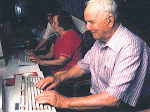 |
| Retired rodeo clown Moyce Evans practicing a basic subluxation support maneuver on a classmate |
What these people all have in common is a chiropractic subluxation of the spine. A subluxation is a complex of functional and/or structural and/or pathological articular changes that compromise neural integrity and may influence organ system function and general health. Experts of the spine known as chiropractors undergo rigorous training in diagnosing and treating subluxations, which are potentially life threatening and can be found in virtually 100% of the population. Many are found in a dormant stage in seemingly asymptomatic individuals.
Historically, people with symptomatic subluxations have had to call and make an appointment to see a chiropractor, sometimes having to wait until later that afternoon or even the next day to be evaluated and receive treatment. But anecdotal experience compiled over the years since the discovery of chiropractic by Daniel David Palmer in 1895 has revealed that the sooner a patient is seen, and an appropriate course of spinal manipulation initiated, the better the outcome. Acting during the so called golden hour of subluxation management can mean the difference between a month of biweekly adjustments followed by lifetime maintenance adjustments, and 2 months of weekly adjustments followed by lifetime maintenance adjustments.
In response to the clear need for more immediate assistance to be available for subluxation emergencies, the American Spine Association has developed a Basic Subluxation Support (BSS) course for the public. The American Spine Association is the nation's oldest organization devoted to spinal health through the diagnosis and correction of subluxations. Their BSS program delivers more than simply an algorithm for stabilizing a subluxation until more advanced chiropractic intervention can be arranged. It offers hope.
The key to success for the BSS program will be increasing public awareness of how vital early spinal adjustments can be during subluxation emergencies, but also improving access to an activator. An activator is a handheld spring-loaded device that allows the targeted application of force to individual vertebral bodies. These low force adjustments can adjust the spine without causing injury.
The mission of the American Spine Association's BSS program is to reduce disability and death from spinal subluxation emergencies by improving the chain of manipulation in every community and health care system. Their goal is to increase the quality and timeliness of activator use, identify and expand training, document outcomes and improve effectiveness. This can be best conceptualized as interlocking pieces of a puzzle, with each piece necessary for visualizing the big picture, but not sufficient on its own.
The 5 pieces of the puzzle are
1. Immediate recognition of a subluxation
2. Early implementation of simple chiropractic adjustment techniques
3. Rapid use of an activator
4. Effective advanced subluxation support
5. Integrated post-adjustment care consisting of advanced acute and maintenance chiropractic adjustments
A completed puzzle can improve outcomes and reduce the likelihood of long term disabilities related to spinal subluxations.
 |
| An activator, shown here being used by a bystander on an infant with colic at an Olive Garden |
The 5 pieces of the puzzle are
1. Immediate recognition of a subluxation
2. Early implementation of simple chiropractic adjustment techniques
3. Rapid use of an activator
4. Effective advanced subluxation support
5. Integrated post-adjustment care consisting of advanced acute and maintenance chiropractic adjustments
A completed puzzle can improve outcomes and reduce the likelihood of long term disabilities related to spinal subluxations.

No comments:
Post a Comment